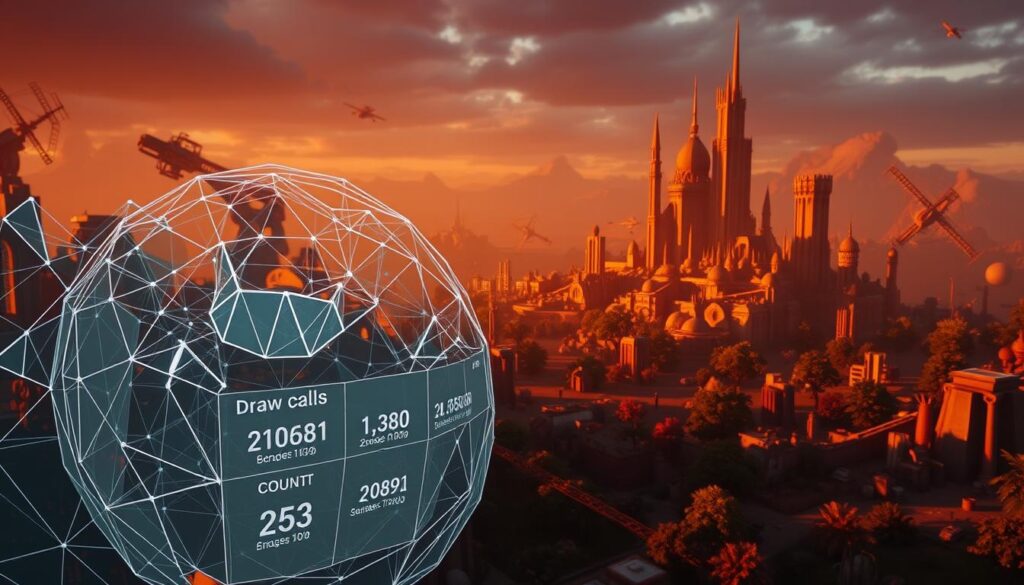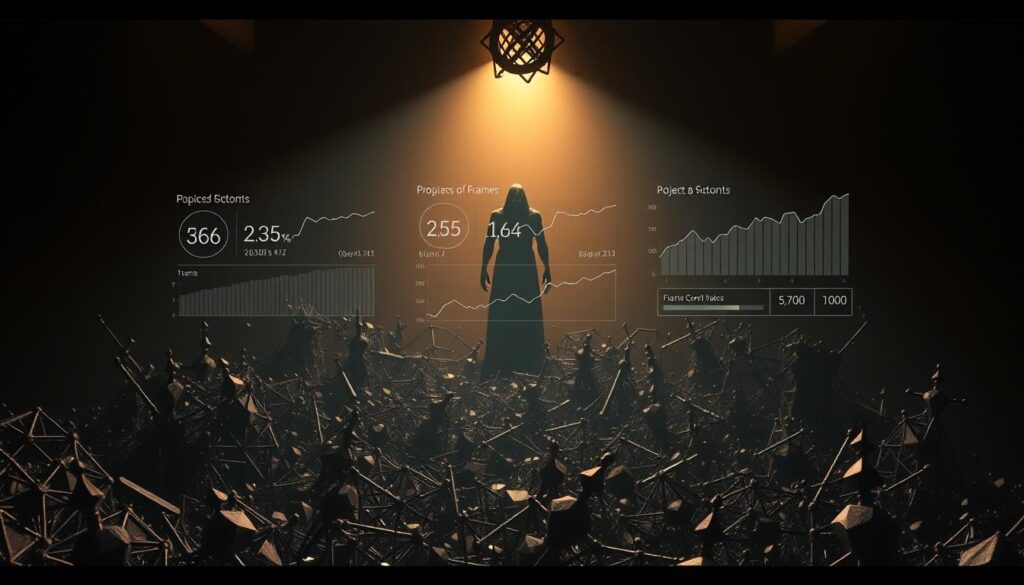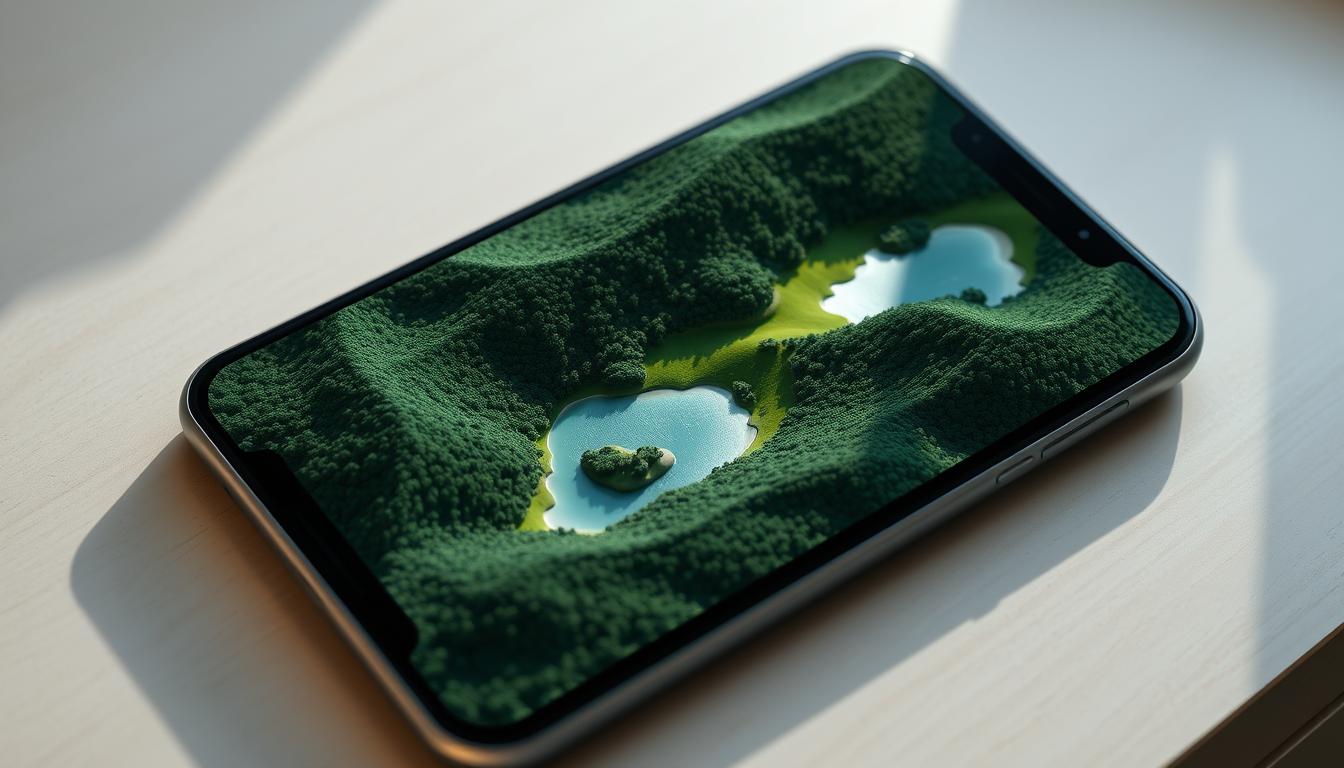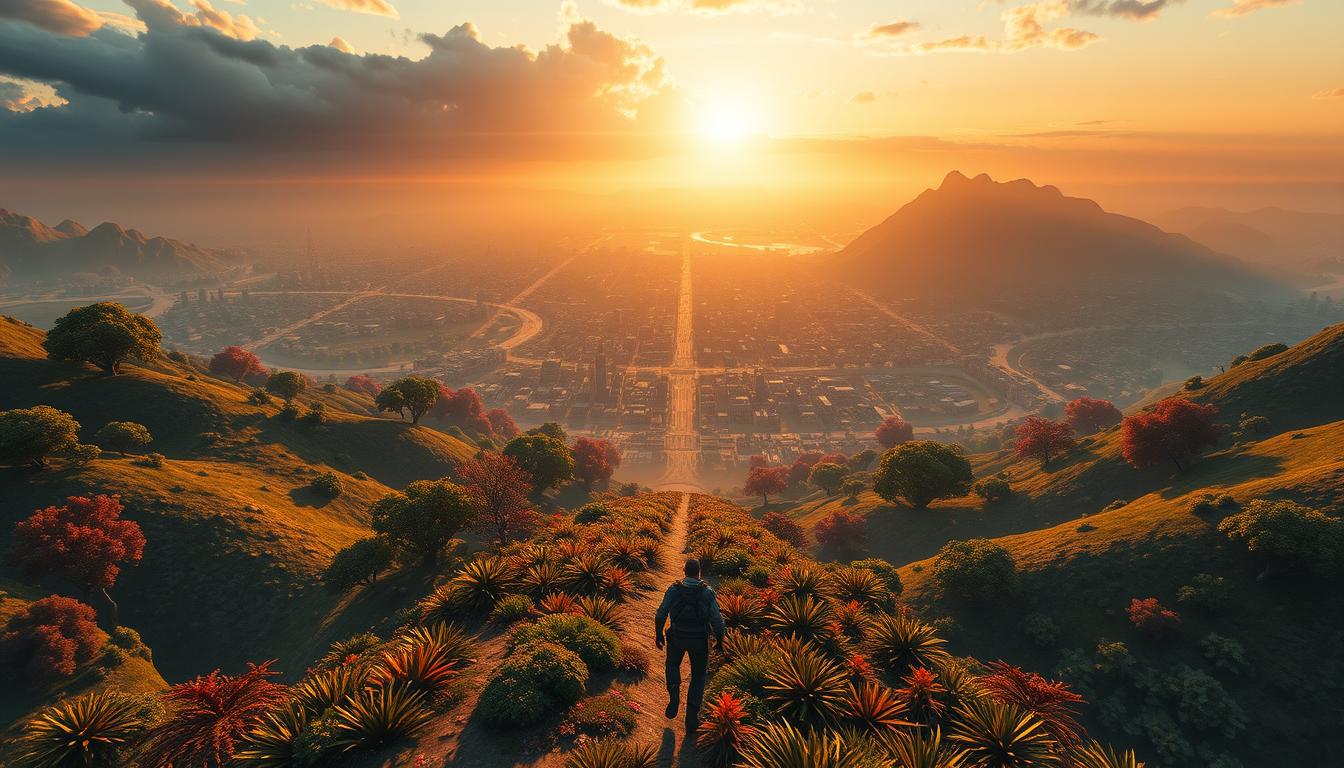Ever noticed how some 3D worlds run smoothly, while others lag, even with similar graphics? It’s often because of how they handle draw calls. We’ll explore why draw calls matter and how making them more efficient can boost performance. This is especially true for worlds filled with lots of objects.
For game makers, knowing about draw calls is key. It helps them create games that look great and run well, without using too much memory. This balance is essential for a good gaming experience.
Understanding Draw Calls in 3D Environments
Draw calls are important requests to the GPU to show objects in a 3D world. In 3D rendering, each call starts a process. The graphics processor turns 3D data into 2D images we see on screens. How well these calls work affects how fast and smooth scenes are.
When many objects share the same texture but have different materials, it can lead to a lot of draw calls. This can slow down games and make them less interactive. It’s key to know how often draw calls happen and how to manage them to improve performance.
Working to make draw calls more efficient helps games run smoother and look better. Developers are always looking for ways to keep 3D rendering quality high while using fewer draw calls. Making this area more efficient is crucial for a great gaming and simulation experience.

The Impact of High Object Volume on Performance
A high object volume in a 3D scene can really affect game performance. When many objects are in a scene, rendering systems have a hard time. This leads to performance issues like lower frame rates and stuttering visuals.
In complex gaming environments, managing object volume is key. Many objects increase memory usage, making rendering harder. This can cause texture problems, making the game look less sharp.

To solve these problems, developers need to optimize object management. They must find a balance between how good the game looks and how well it runs. By understanding the effects of many objects, they can improve rendering strategies. This ensures the game runs smoothly, even with lots of details.
Basic Techniques for Optimizing Draw Calls
Optimizing draw calls is key to better rendering in 3D worlds. Using smart performance techniques can make games and apps run smoother. One basic way is to merge meshes. This means combining several objects into one, cutting down on the number of draw calls needed.
Instancing is another great way to optimize draw calls. It lets you show many copies of the same object with just one draw call. This makes the game run smoother and uses less of the graphics card’s power.
Batching similar objects is also helpful. Artists can group objects with the same look together. This way, they need fewer draw calls but still keep the visuals sharp. These methods help developers make their 3D scenes run better and look great.
Draw Call Minimization in Open World Procedural Maps
Optimizing open world games is tough, especially with lots of objects in procedural maps. High object density can slow down games. So, reducing draw calls is key for better performance.
Static batching helps by combining objects into one mesh. This cuts down on draw calls, especially for static objects. Dynamic instancing is great for moving objects, allowing for many instances of the same object to be shown.
By working on draw call minimization, game makers can make the game better for players. They keep the game fast and looking good by using these smart techniques. This makes the game world more fun and real.
Leveraging Instancing to Reduce Draw Calls
Instancing is a key tool for making graphics in 3D environments better. It lets the same objects share the same mesh and material. This cuts down the number of draw calls needed during rendering.
This is especially true in scenes with lots of the same thing, like forests or cities. It makes scenes look smoother and more detailed.
Instancing works by saving memory. Instead of loading many copies of the same object, it uses just one. This saves memory and makes things run faster.
Games and simulations really benefit from instancing. It lets them have more complex scenes without slowing down. This makes the experience more real and fun.
Utilizing Texture Atlases for Improved Efficiency
Texture atlases bring big wins in performance and resource use for games and graphics apps. They merge many textures into one image. This cuts down on rendering time and memory use.
This method is key in games with lots of objects. It helps keep the game running smoothly.
Combining Multiple Textures into One Atlas
Making a texture atlas means arranging many textures in one image. This makes the rendering engine work less hard. It sends fewer requests to the GPU, speeding up the process.
The good stuff includes:
- Less work for the rendering engine, making things faster
- Smoothes out texture changes, making graphics flow better
- One texture to handle, making the pipeline simpler
Reducing Memory Footprint and Draw Calls
Texture atlases also cut down on memory use. This is great for games needing high-quality assets. They help manage memory better, leading to:
- Less memory needed, so more assets can be loaded at once
- Fewer draw calls, letting scenes get more complex without slowing down
- A better graphics pipeline, ready for advanced techniques
Employing Level of Detail (LOD) Optimization
Level of Detail (LOD) optimization is key to better rendering in 3D worlds. It changes object details based on the camera’s distance. This means fewer polygons are used, improving performance and visual quality.
When objects are far away, using simpler models is crucial. This boosts performance and makes games run smoother. It’s a smart way to use resources for better rendering.
Adding LOD optimization to games or 3D simulations helps a lot. It makes sure games look great without slowing down. This is vital for making games that work well on all devices.
Procedural Mesh Generation and Simplification Techniques
Procedural mesh generation is key in making complex environments in real time. It uses special algorithms to make things more efficient and still look good. This is crucial for games and simulations that need to create things on the fly.
Mesh simplification is also important for better performance. It makes objects have fewer polygons but still look good. This is especially helpful when there are lots of objects, like in games with lots of detail.
The table below shows different mesh generation and simplification methods. It explains what they do, their benefits, and where they’re used:
| Technique | Description | Benefits | Application Areas |
|---|---|---|---|
| Voronoi Tessellation | Creates irregular polygons based on points in space. | Supports complex pattern generation. | Terrain generation, architectural models. |
| Octree Simplification | Breaks down meshes into smaller parts for ease of processing. | Improves rendering speed by reducing detail in distant objects. | Large-scale environments, open-world games. |
| LOD Generation | Creates multiple levels of detail for 3D models. | Enhances performance by loading lower-detail models at distance. | Video games, virtual reality, simulations. |
| Mesh Decimation | Removes vertices while preserving mesh shape. | Downsized data for better resource management. | Scenic environments, crowd simulations. |
Using these strategies, developers can make games and simulations better. They make sure things look good and run smoothly, which is key for creating immersive experiences.
Using Geometry Shaders for Advanced Rendering
Geometry shaders are a big step forward in 3D graphics. They work on the GPU to change mesh data before it’s shown. This lets developers make more detailed shapes without sending more data to the GPU.
Understanding Geometry Processing Benefits
Geometry shaders make the rendering process smoother. They help by reducing the need for extra data uploads. This makes the process more efficient, leading to several benefits.
- Dynamic Mesh Generation: Create geometry at runtime, reducing pre-processing time and resource consumption.
- Enhanced Detail Levels: Introduce more detail only where necessary, optimizing performance in complex scenes.
- Flexible Rendering Techniques: Adjust rendering parameters on-the-fly, adapting to different visual requirements.
Geometry shaders are especially useful in big scenes, like open worlds. They help artists and developers make scenes look great without using too many resources.
| Feature | Benefit |
|---|---|
| Dynamic Geometry Creation | Reduces data transfer needs and improves frame rates. |
| Real-time Adaptability | Enhances rendering techniques on-the-fly based on viewer perspective. |
| Level of Detail Control | Optimizes resource usage, focusing detail where it matters most. |
Batching Techniques to Improve Performance
In the world of 3D environments, batching techniques are key to better performance. They combine multiple draw calls into one, cutting down CPU work and boosting GPU use. This is especially important in scenes with lots of objects.
There are different ways to use batching techniques, each for different needs:
- Static Batching: This method groups objects that don’t move. They must have the same material for smooth rendering. It greatly reduces the number of draw calls, leading to better rendering.
- Dynamic Batching: This is for objects that move or change often. It groups small, moving objects for better rendering without needing lots of calculations for each object.
Both methods help make rendering smoother in big virtual worlds. Using these techniques improves performance and makes the environment look better.
Memory Management Strategies for Lowering Overhead
Effective memory management is key to better system performance. It’s especially important when dealing with lots of objects. By using the right strategies, developers can make their apps run smoother and use less resources.
Vertex Pooling Methods Explained
Vertex pooling helps manage vertex data to save memory. It reuses vertex buffers to cut down on memory use. This makes data access faster and memory use more efficient, boosting performance in rendering.
Reducing Driver Overhead in Rendering
Memory management also means reducing driver overhead. Fast data transfers between the CPU and GPU make rendering smoother. Minimizing state changes and API calls helps too, leading to better resource use and less delay.
Handling Complex Materials Effectively
Rendering complex materials can slow down 3D environments. Material optimization helps solve this problem. By using simpler shaders, developers can speed up rendering without losing quality.
This makes scenes load faster and easier to manage. It’s a key part of making 3D environments run smoothly.
Another good strategy is using shared material instances. Instead of making a new material for every object, shared instances save memory. This makes rendering faster, especially with lots of objects.
Occlusion Culling for Increased Efficiency
Occlusion culling is key to better performance in 3D rendering. It makes sure only visible objects are rendered, saving a lot of processing power. This is especially useful in big environments where many objects aren’t seen by the player.
Using occlusion culling keeps games running smoothly and fast. It helps keep frame rates high and gameplay smooth.
There are many occlusion methods, each suited for different environments. For example, PVS algorithms figure out visibility through complex math. Depth-based occlusion checks depth quickly. These strategies boost rendering efficiency a lot.
In areas with lots of objects, occlusion culling makes a big difference. It improves both visuals and the overall gaming experience. Making occlusion culling a priority in game design can greatly enhance the player’s experience.
| Method | Description | Performance Gain |
|---|---|---|
| Potentially Visible Set (PVS) | Calculates visible objects based on the viewer’s location. | High, especially in densely populated areas |
| Depth-Based Occlusion | Uses depth information to quickly assess visibility. | Medium, fast for real-time applications |
| Portal Occlusion | Determines visibility through defined portals in environments. | High in structured environments with defined paths |
Combining Information for Advanced Draw Call Reduction
To cut down on draw calls, developers must focus on information combining and advanced optimization. They can boost rendering efficiency by using different optimization methods. This includes combining assets in a way that’s smooth and efficient.
By removing unnecessary steps in the rendering process, developers can make things run smoother. This is done through advanced render state management. It helps manage graphics states better, making the whole process more efficient.
When these methods work together, they create a powerful effect. This allows for handling lots of objects without increasing draw calls. The end result is a more detailed and vibrant 3D world, all while saving on computer resources.
Real-World Applications and Case Studies
Many industries, like gaming and virtual simulations, use draw call minimization. This helps improve performance and user experience. Developers have seen great results by using these strategies.
A top game development studio used instancing and texture atlases. This cut down rendering time, making environments richer without losing speed. Players enjoyed smoother gameplay, even in busy areas.
In architectural visualization, a firm used geometry shaders and LOD. This reduced rendering time, making previews and client reviews faster.
These examples show how different fields apply draw call minimization. They offer lessons for other developers looking to optimize their work.
Conclusion
This article shows how important draw call optimization is for better rendering in open world maps. Using methods like instancing, texture atlases, and level of detail can greatly reduce draw calls. This makes graphics smoother and the experience more immersive.
Advances in geometry shaders and batching also help improve graphics. These tools let developers create more realistic graphics in real-time. Keeping up with new optimization methods is key to staying ahead in procedural world design.
Developers can use these tips to improve their current projects and keep learning. The future holds even more ways to reduce draw calls. Staying updated is crucial in this ever-changing field.
FAQ
What are draw calls and why are they important in 3D rendering?
Draw calls are requests to the GPU to render objects in 3D. They’re key because too many can slow down performance. This is especially true for real-time applications.
How do high object volumes affect rendering performance?
Too many objects in a scene can slow down rendering. This can cause texture issues and lower frame rates. Managing objects well is essential for smooth performance in complex scenes.
What are some basic techniques to reduce draw calls?
To cut down on draw calls, merge meshes and use instancing. Batching similar objects also helps. These methods ease the GPU’s workload, making rendering smoother.
How does instancing help in reducing draw calls?
Instancing lets identical objects share the same mesh and material. This cuts down draw calls significantly. It’s great for scenes with lots of the same elements, like trees or buildings.
What are texture atlases and how do they improve efficiency?
Texture atlases combine multiple textures into one image. This reduces draw calls and memory use. It makes rendering more efficient by cutting down GPU requests.
What is Level of Detail (LOD) optimization?
LOD optimization changes object complexity based on camera distance. It reduces polygon processing, boosting performance while keeping visuals sharp.
How do geometry shaders contribute to advanced rendering?
Geometry shaders process vertex data on the GPU, allowing for mesh changes before rendering. This boosts rendering flexibility and can cut down on data uploads.
Why is memory management important in rendering performance?
Good memory management reduces memory use and improves resource allocation. It helps speed up rendering in real-time applications.
What role does occlusion culling play in rendering efficiency?
Occlusion culling only renders visible objects. This saves processing power and boosts efficiency in big environments.
Can you provide examples of real-world applications for draw call minimization strategies?
Yes, these strategies have improved performance in gaming and virtual simulation. They’ve led to better resource management and faster rendering speeds.




